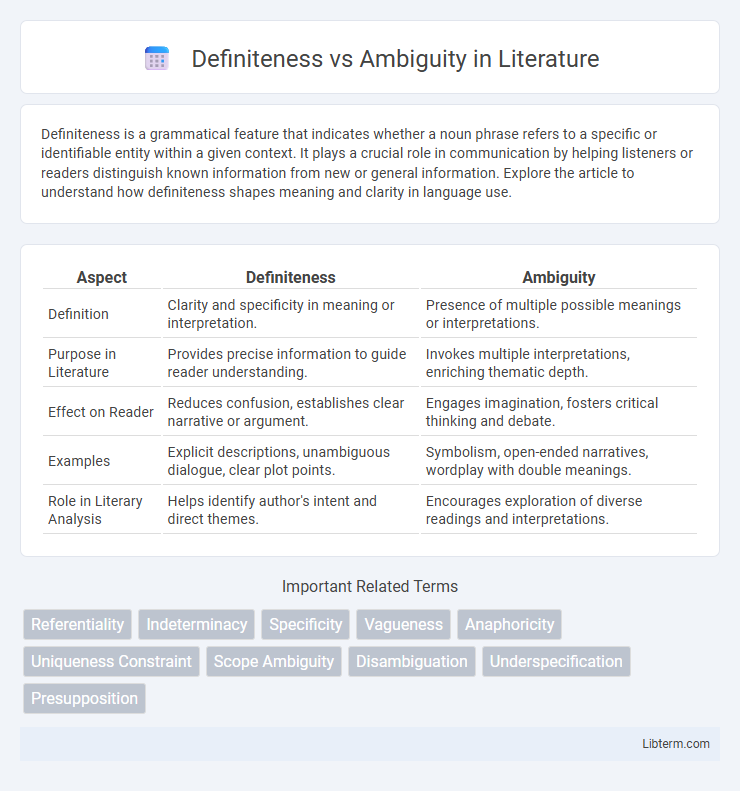Definiteness is a grammatical feature that indicates whether a noun phrase refers to a specific or identifiable entity within a given context. It plays a crucial role in communication by helping listeners or readers distinguish known information from new or general information. Explore the article to understand how definiteness shapes meaning and clarity in language use.
Table of Comparison
| Aspect | Definiteness | Ambiguity |
|---|---|---|
| Definition | Clarity and specificity in meaning or interpretation. | Presence of multiple possible meanings or interpretations. |
| Purpose in Literature | Provides precise information to guide reader understanding. | Invokes multiple interpretations, enriching thematic depth. |
| Effect on Reader | Reduces confusion, establishes clear narrative or argument. | Engages imagination, fosters critical thinking and debate. |
| Examples | Explicit descriptions, unambiguous dialogue, clear plot points. | Symbolism, open-ended narratives, wordplay with double meanings. |
| Role in Literary Analysis | Helps identify author's intent and direct themes. | Encourages exploration of diverse readings and interpretations. |
Understanding Definiteness and Ambiguity
Definiteness in language specifies a particular entity known to the speaker and listener, often marked by definite articles like "the" or demonstratives such as "this." Ambiguity arises when a phrase or sentence has multiple possible interpretations, causing uncertainty in meaning due to unclear reference or context. Understanding definiteness and ambiguity is crucial for precise communication, enabling speakers to convey specific information while recognizing potential sources of confusion.
Definitions and Key Concepts
Definiteness refers to expressions that unambiguously identify a specific entity within a given context, often marked by definite articles or unique descriptors. Ambiguity arises when a phrase or sentence allows multiple interpretations, causing uncertainty in reference or meaning. Understanding the distinction is crucial in linguistics and natural language processing for accurate comprehension and communication.
The Role of Definiteness in Communication
Definiteness plays a crucial role in communication by providing clarity and specificity, enabling listeners to identify exactly which entity or concept is being referred to. It reduces ambiguity by signaling shared knowledge or introducing new information clearly, thus facilitating efficient information exchange. The use of definite articles, demonstratives, and possessives helps anchor discourse, making the speaker's intent more explicit and minimizing misunderstandings.
Sources and Examples of Ambiguity
Ambiguity arises from lexical, syntactic, and semantic sources, making interpretation context-dependent and often unclear. Lexical ambiguity occurs when a word has multiple meanings, such as "bank" referring to a financial institution or a river edge, while syntactic ambiguity emerges from sentence structure, exemplified by "I saw the man with the telescope," which can mean either using the telescope or describing the man. Semantic ambiguity involves vague or imprecise meanings, like in the phrase "She didn't see the dog," which can imply either the dog was unseen or the act was not performed.
Linguistic Markers of Definiteness
Linguistic markers of definiteness include definite articles such as "the" in English, demonstratives like "this" and "that," and possessive pronouns indicating shared knowledge or specific reference. These markers signal that the speaker assumes the listener can identify the referent uniquely within the discourse context, reducing ambiguity. Indefiniteness often lacks these specific markers, leading to broader or less specified interpretations.
Ambiguity in Syntax and Semantics
Ambiguity in syntax arises when a sentence structure allows multiple grammatical interpretations, such as in the classic example "I saw the man with the telescope," where it's unclear who possesses the telescope. Semantic ambiguity occurs when a word or phrase has multiple meanings, leading to different interpretations based on context, like the word "bank" referencing either a financial institution or a river edge. Both syntactic and semantic ambiguities challenge natural language processing by complicating tasks such as parsing, meaning extraction, and disambiguation in computational linguistics.
Effects of Definiteness on Clarity
Definiteness enhances clarity by specifying a particular entity, reducing the risk of misunderstanding in communication. Using definite articles like "the" or demonstratives such as "this" directs the listener's or reader's attention to a known or previously mentioned subject. In contrast, ambiguity arises when indefinite references create multiple possible interpretations, weakening the precision of the message.
Strategies to Avoid Ambiguity
Clear communication relies on definiteness, which eliminates ambiguity by providing specific, unambiguous information. Strategies to avoid ambiguity include using precise language, defining terms clearly, and structuring sentences to convey one clear meaning. Employing concrete examples and avoiding vague pronouns further ensures that the intended message is understood accurately.
Cultural and Contextual Influences
Definiteness in communication varies significantly across cultures, where some societies prioritize clear, explicit information to avoid misunderstandings, while others value ambiguity as a means of politeness or relational harmony. Contextual influences such as social hierarchy, setting, and the relationship between interlocutors shape whether messages are conveyed with precision or left deliberately vague. Understanding these cultural and contextual nuances is essential for effective cross-cultural communication and reducing misinterpretations.
Practical Applications and Implications
Definiteness enhances clarity and precision in communication, which is critical in legal documents, contracts, and technical writing to prevent misunderstandings or disputes. Ambiguity, while sometimes useful in creative fields like literature or marketing to engage diverse interpretations, can lead to confusion or errors in decision-making processes and software development. Practical applications emphasize the need to balance definiteness for accuracy and ambiguity for flexibility depending on the context and audience requirements.
Definiteness Infographic

 libterm.com
libterm.com